|
History of Meat Eating in Japan
The history of meat-eating in Japan is generally considered quite mysterious. Retracing
its history, however, leads us to find it quite unique and interesting.
It was only 18 or 19 centuries ago, sometime during 100s-200s AD when Chinese
characters were brought to this country. Until then, they had no way to
make documents of their life style, their own culture, or anything else,
therefore, there are no written documents whether the people before the
era ate meat or not. Compared to historical facts in other countries where
they owned their own letters since ancient time, it seems to me that Japanese
people might have not had good ability for keeping their documents.
However, some archeologists have reported that people hunted wild animals
in the field and caught fish and other mammals in the sea in ancient time.
They found pieces of roasted or broiled bones and other remnants of the
animals and fish in the archeological sites they had dug. Accordingly,
during the period from 400BC through 200AD, it is thought that people kept
hogs as their livestock. However, there is rather a long period for about
12 centuries when meat eating was banned by the commands of the emperors
and also from Buddhism teaching which was imported from the Asian continent
in the 7th century. This prohibition was implemented only among the Buddhist
priests and people in high society in early years. Ordinary people, mostly
farmers, who were not intelligent enough to learn imported cultures had
no chance to learn about Buddhism yet. As it gradually infiltrated deeply
into ordinary people such as farmers and merchants as well, they started
to follow the teaching and began to avoid meat eating.
Prohibition of Meat-Eating
Why did Buddhism prohibit people from eating animal meat? It was not only
animal meat but the meat of all living creatures including fish and other
sea food. It was and is the teaching of Buddhism not to take the life of
any animal and living creature, which strongly influenced the dietary habits
of most Japanese until the middle of the 19th century, when the western
life style came into this country. The ordinary Japanese did not eat meat
during this long period of time, except those who were privileged to eat
the game animals and birds as medicinal eating. What an excellent excuse
it sounds while most of other people were banned from eating meat! Generally,
it is believed that the emperors who reigned one after another, since 7th
century when Buddhism came to Japan, took advantage of the Buddhist teaching
to keep and sustain the peace and stability of the nation. They did not
want their people to eat animal meat and gain too much energy from it.
They tried to oppress and tame their people to keep the peace and harmony
of the nation. It is quite understandable that the emperors of those ancient
eras took advantage of the Buddhist teaching to sustain the peaceful situation.
However, there are some cultural anthropologists or historians who assert
that people then used to beliebe the God of Agriculture would get angry
if the farmers ate animal meat during the farming season, summer and autumn.
They believed that God would set locusts free all over the farms in order
to destroy all the crops and other farm products. So the emperors of the
time prohibited people from eating meat only from April through September.
it must have been good method to controle and discipline the farmers to
keep them away from extravagant life. They were expected to work diligently
and constantly in order to produce the necessary food not for the farmers
themselves first but for their rulers of high society.
Whichever report may be true, it seems quite pity to us who can afford
to eat any meat today, that most of our ancestors had never been allowed
to eat any meat and that they did not know how it tasted for such long
period of time. After the Chinese and the Westerners brought their food
and cooking techniques to this country around mid-17th century, the Japanese
were exposed to different types of meat. This was limited only to the very
few people in the limited societies then.
Who Ate Beef First in Japan ?
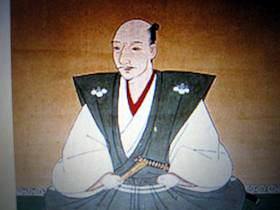
Whether it is true or not, there is an interesting report that the person
who tried beef for the first time in Japan was Oda Nobunaga, a provincial
leading Samurai with great power in 17th century who tried to unsuccessfully
unite Japan as a nation. He was betrayed and driven to the corner where
he could not help committing suicide by hara-kiri by one of his retainers.
However, the place where he built a beautiful and gorgeous castle of his
own is right in the center zone where beef was and is recognized as the
best in Japan even today. The beef from there is called Omi-beef. I am
sure people living there then must have eaten some beef in a sly manner
from time to time while it was banned, and they must have gifted Nobunaga
with their delicious beef.
Opening of the Country and Meat-Eating
The Japanese people were allowed to eat meat freely after Perry came from
America in black boats in order to force the Tokugawa Government to open
their country to the world in 19th century. The feudal age of the Tokugawa
Shogunate ended. Japan opened herself up to the world, especially to the
western part of it. It started adopting new western cultures.
People then were so eager to grow as civilized people adapting the western
style of dietary life. They ate meat timidly and gingerly at first and
trained themselves to get accustomed to it.
Some superstitious people are said to have believed that they might have
horns on their heads if they ate beef. Even after the meat eating was liberated
in mid-19th century, the people in Japan did not eat much meat at a time
and not frequently either.
Until recently, when many western type restaurants appeared and started
serving many western dishes, the way the Japanese cooked meat was limited
almost only to slicing it thinly or cutting it into small pieces and cooking
it in the same way as they cooked seafood following their own traditional
way. They had never experienced cooking a big lump of meat or even a whole
chicken. I have often gotten a question from my students, “Why is Japanese
meat all sliced thinly in the market?“
Meat in Japan is generally sold already cut and sliced according to the
consumer’s needs and conveniences. And it is easier for the Japanese who
eat food with chopsticks.
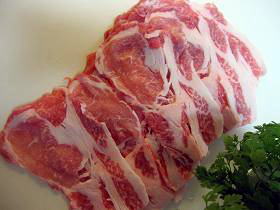 |
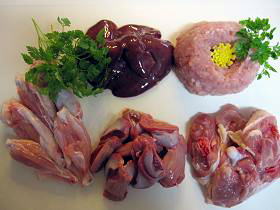 |
Meat Eaten in Japan
Beef, pork and chicken is most commonly available in most of the meat
markets where the average Japanese people buy meat for their daily life.
Small amounts of imported lamb and frozen whole turkeys are available only
in big cities like Tokyo and only in selected shops. Japanese people are
not accustomed to eating lamb or turkey. However, game animals are available
during the hunting season. They are sold at selected meat shops and served
at the restaurants that specialize in serving game meat. The popular game
meat includes deer, wild boar, and bear. In some areas and at some restaurants,
you may find horse meat served as sashimi and sukiyaki.
As an attempt to get the tender wild boar, a cross between a wild boar
(inoshishi) and pig (buta) called inobuta is produced by some farmers.
Hunters also hunt ducks and pheasants in their seasons. Some farmers produce
a hybrid between the goose and the duck called aigamo. This meat is tender
and flavorful, and may be used at some restaurants as a substitute for
duck.
For the past 20 years, the consumption of meat in Japan has increased
up to 3 times. It seems to be related to the economical prosperity of the
country. It is reported that in China the consumption of animal protein
has been drastically growing recently; it is clear the economical prosperity
of a nation affects their dietary life. As Japanese eat more meat their
cooking repertory expands.
Until recently, they cooked meat only in limited ways such as sukiyaki
(pot cooking on the table) or curry and rice.
Nowthey enjoy it in many different ways such as shabu shabu, Korean barbecue,
steaks, stew, roast beef or pork.
Whale Meat in Japan
Japan is one of a few countries where whale meat is eaten, not by its
whole population but mostly by those in a few areas along the seashore
where whales get close. This matter is very controversial in
the world these days. The whale is not a fish although it lives in the
ocean. Unlike the meat of other mammals, whale is not handled like other
meats. It is sold at fish markets together with fish.
It seems just a matter of transportation. Since it is hunted or captured
from the ocean it is brought to fish markets. Living in a big city like
Tokyo, we seldom have chance to see whale meat in fish markets, although
there is a whale meat restaurant near our neighborhood.
Whale meat is no longer eaten as much as it used to after the World War
II. The people of my age who entered primary schools in the year the war
ended, were often fed with whale meat as school lunch. It smelled and tasted
awful to me and I do not have good impression of it. The fresh whale meat
looks just like beef but tastes fishy. I have not tried it since I was
a child.
Actually,I had no idea whether whale meat is eaten casually in Japan these
days until Sea Shepherds from Australia and a few more other countries
appeared all of a sudden in the ocean and attacked the Japanese whale test
hunting boats or visited a whale fishery village to protest against the
whale fishery by the villagers.
Whatwe eat or do not eat is a matter of culture. I believe most of the
people in the world agree. We could ask why the Australians eat kangaroos.
We have no kangaroos in Japan. A small number of them are kept in zoos
or children see them in animal picture books. They are lovely animals and
not the animal for us to eat. But we would not even ask the Australians,
Why do you eat kangaroo meat, simply because we believe it is their own
culture to eat it.
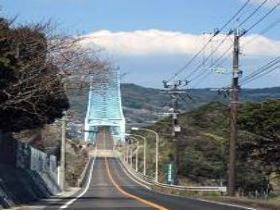 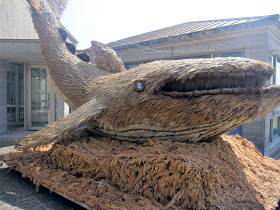 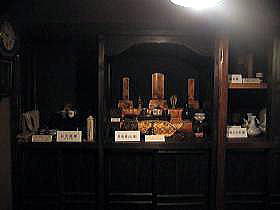
Last summer, I visited a small island in Nagasaki which is known for the
history of hidden Christians. Surprisingly, I found a museum building in
which both the culture of whale fishery and hidden Christianity were shown
in the same museum building. Both cultures are quite important for the
residents of the island.
Beef
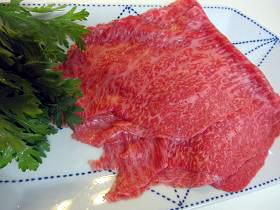 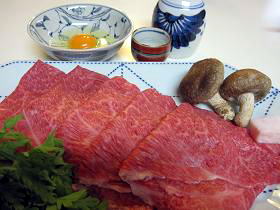
One of the questions I always receive when I start a new cooking class
for foreigners each year is why the beef in Japan is so expensive. There
are several reasons.
First of all, the Japanese appreciate very tender, well-marbled beef and
consider it the best.
They describe the tenderness as "so tender that it almost melts on
our tongues." I was very much surprised when I first saw a portion
of fillet which was beautifully marbled. The cattle raisers in Japan even
try to marble the fillet. They also like the flavor from the marbled fat.
Marbled beef is tender and it is fat that gives special flavor. In order
to obtain this well-marbled meat, there is the legendary story of how these
cattle are raised by hard-working women.
Many beef cattle used to be raised in twos and threes by farmers. Since
pastureland is limited in Japan, they kept the cattle in barns most of
the time giving them less exercise for softer muscle and feeding them well
for fattening.
They said the daughters of the farmers even massaged the cattle to promote
marbling and make the muscle tender, and hopefully to sell them at the
highest possible price, so that their parents were able to buy good, expensive
furniture when they got married.
It is true that farmers feed the cattle with beer and massaged them. Whether
you believe it or not, the cattle love beer. They get relaxed after drinking
some beer just like us. When they get relaxed, they are massaged so that
the fat spreads all over their muscles.
Farmers have to pay big money to buy an offspring of the expensive cattle
which have an award record and certificate with nose print. This definitely
helps to boost the beef price.
In daily life, the Japanese did not eat beef as often and in the quantity
as the Westerners do.
So, even if the beef is marbled and fatty, the Japanese had fewer health
problem until recently. Actually we could not eat much of fatty marbled
beef, we are satisfied with a small amount of it.
In Japan, beef seems more popular and better in the western part of the
country like Kyoto/Osaka/Kobe (Kansai) area. Famous beef such as Kobe beef,
Matsusaka beef, and Omi beef are also from this area.
 Personally, like many others in the Kansai area, I recommend Omi beef as
the number one beef in Japan. Quite recently it was reported on TV that
Shiga Prefecture where Omi beef is produced began selling their proud Omi
beef to Singapore and Thailand with the support of the lady Governor and
the top ranked restaurant chef in Kyoto. My worry is that the price will
grow higher and higher. Personally, like many others in the Kansai area, I recommend Omi beef as
the number one beef in Japan. Quite recently it was reported on TV that
Shiga Prefecture where Omi beef is produced began selling their proud Omi
beef to Singapore and Thailand with the support of the lady Governor and
the top ranked restaurant chef in Kyoto. My worry is that the price will
grow higher and higher.
Today, after a long negotiation between governments, beef is imported from
other countries much more freely than in the past. Domestic and imported
beef is sold at the same place. How can we tell the difference? The price
tells it definitely.
Pork
Although the Japanese abstained from eating meat in general for hundreds
of years until mid-19th century, there are no social and religious restrictions
over pork eating. Although pork is not eaten as much as in China where,
when they say 'meat', it means pork, the Japanese have developed several
good recipes for pork like tonkatsu (deep-fried breaded pork cutlet) and
shoga-yaki (sautEed pork with ginger flavor).
The hogs raised in Japan today are mostly from the U.S. and Europe, and
are fed with imported feed. So they should taste more or less the same
as those in the U.S. and Europe. For many years, we have seen the pork
labeled kurobuta (black hog) in Japanese at meat sections of food stores.
The pork is the meat of hogs that actually have purely black fur. The meat
is tender and tasty however you may cook.
Even if it is cooked in strongly flavored curry, you surely can tell what
it is.
As mentioned elsewhere, for those epicureans who try to eat something
different, a hybrid between a pig and a wild boar is raised to keep the
flavor of a wild boar with the tenderness of pork. At home, we often do
one-pot cooking with pork slices and leaf vegetables and eat it with soy
sauce and rice vinegar. It is simple and delicious.
Tokyo X
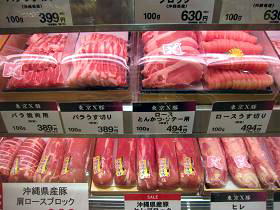
Whether you believe or not, this strange name, Tokyo X is a brand name
of pork raised in Tokyo, not in skyscrapers, but in pastures. Tokyo is
a big city, but only a small part of the prefecture. The city area of what
is called Tokyo 23 wards (Special District) is only 1/3 of whole Tokyo
prefecture. The There are some plains and farming area and pastures as
well. When I found this pork with this strange name, I promptly asked a
sales lady of the meat shop, What is Tokyo X? She answered proudly, It's
the pork raised in Tokyo and we are very proud of it . Why not try it?
I could say Tokyo X is the pork from which all the negative characteristics
of pork have been eliminated.
The meat isso tender, juicy, and tasty, good for Tonkatus, breaded pork, Ginger Pork, and of course Shabu Shabu.
Chicken
Chicken and I
The readers of this manuscript might question my cooking ability if I
say I do not have a good impression of chicken and it is not my favorite
bird meat. Why? When I was a child, I used to live with my grand-mother
in the country. She kept some chickens in the yard to get eggs every morning.
The chicken egg was an important source of protein in my childhood. Five
or six young chickens in different colors were kept in a cage most of the
time, but grandma let them out of the cage for exercise when the weather
was good. She said that it was my duty to bring them back to the cage in
the evening. The chickens were not wild but they did not listen to me.
They were so disobedient to me.
I was not patient or sweet to them, either. I got mad at them, fought
with them, and did not like them at all. Moreover, grandma did not like
to see me get mad at her chickens and gave me a hard time. When any of
her chickens no longer laid eggs, a young man in our neighborhood would
come and help to prepare them, one after another, for special dishes on
special occasions. Out of curiosity, one day,
I watched carefully how the young man prepared the poor chicken. I got
sick. At the same time I felt so sorry for the chickens I had been fighting
every day; I could not eat their meat.
Chicken in Japan:
Whenever it is in a big shop specializing in chicken or a chicken section
of a supermarket, there are always several different kinds or brands of
chicken these days. In addition to regular broiler, they now have free-range
chicken, chicken of special brand (local species); grown up to 35-day olds,
and 100-day olds. Broiler chicken today tastes just about the same as
you eat in the States. The original breeding hens are from the States,
are kept in the same air-conditioned houses as you may find in Maryland,
and are fed with the feed mostly imported from the Mid-West.
The Japanese are taking care of them, which does not affect the taste
of chicken. Free-range chicken and chicken of special local species are
usually kept a little longer than broilers and fryers.
Their meat is slightly firmer in texture but richer in flavor and more
expensive.
In Japan, chicken meat displayed in a store's showcase is usually separated
into parts such as breast and leg and thigh with or without skin and with
or without bones, fillet, drumstick, and wing. Breast and leg and thigh
meat is cut into even smaller pieces for the sake of convenience in Japanese
cooking. Ground chicken, liver, gizzard and egg yolk from hen s ovary duct
are also available at markets. Beautifully prepared whole chicken is also
available. In the past, the crest was used to treat a child who wet the
bed, but it is no longer these days. Feet are mostly exported to China
where young ladies love them.
 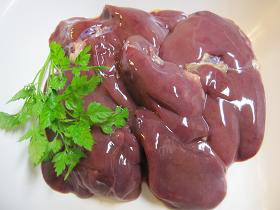 
Keiko Hayashi |